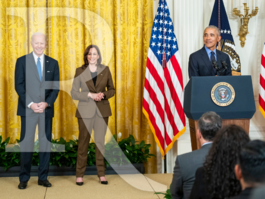The Running Mate Dilemma
A Commentary By Joe Conason
The selection of a vice president is not only an exercise in political handicapping but also a national rite of statecraft. Candidates, advisers, pundits and assorted experts try to calculate the ethnic, geographic, gender and ideological characteristics of potential running mates, but what this choice actually reveals is the character of a presidential nominee.
For Barack Obama, the choice of a vice president is a test of his self-confidence and his vaunted judgment. Should he seek to mollify the disappointed Clinton supporters, especially among his party's women? Or should he try to balance his own political weaknesses with somebody else's strengths? Will he attempt to win a region with his choice, or even one crucial state?
For John McCain, this decision will reflect the character issue that is now at the center of his campaign. Should he try to motivate the sullen base of the Republican Party by picking a right-wing hard-liner? Or should he renew his appeal to independents and even Democrats with a fresh-faced reformer? Can he strike deep into the opposition by choosing a female or minority candidate (or both)?
For either candidate, the selection process may be complicated by extraneous considerations. Suffering under a financial disadvantage, for example, the Republican campaign could be tempted by the likes of Mitt Romney, whose willingness to spend his own millions on negative ads certainly impressed McCain during the primaries. It is hard to imagine any other reason why the straight talker would tap a politician he so ardently despises.
Meanwhile certain leaders of the religious right are openly promoting the candidacy of Mike Huckabee, the former Arkansas governor and extinguished fad of the early primaries. Personable as he is, Huck nevertheless emphasizes the Republican extremism that is now out of favor with most American voters. He also talks too much and says stupid things about shooting people.
So perhaps McCain, who will turn 72 just before his party's convention and looks even older, would do better with a young conservative governor like Tim Pawlenty of Minnesota or Bobby Jindal of Louisiana. The only problem with the youth gambit is that a political newcomer on the ticket would undermine his most compelling argument against Obama.
But if McCain confronts quandaries, those faced by his rival are just as difficult. First, Obama must engage in a complex and challenging dance with Hillary Clinton, according her appropriate respect without allowing her to dominate the process. Current polling data indicates that she would be an important asset to the Democratic ticket -- if she really wants the second spot and if Obama can imagine working with her in the White House (with her husband hovering somewhere in the background).
Should that seem impossible, Obama remains obliged to consider the disappointment of women who backed Clinton as their gender's great hope. It will be hard for them to accept that progress toward equality is a zero-sum game in this election cycle. Among the female officials of rank and merit are Gov. Janet Napolitano of Arizona and Gov. Kathleen Sebelius of Kansas. Both endorsed Obama, but neither possesses the national security experience that he may regard as his ticket's most pressing need. Ranking women who do, such as Sen. Dianne Feinstein and Rep. Jane Harman, both California Democrats, differ substantially with him on important foreign-policy issues.
Democrats with the strongest military credentials include Sen. James Webb, the former Reagan Navy secretary who just might capture the electoral votes of his home state of Virginia, and Gen. Wesley K. Clark, who served as supreme commander of NATO during the Clinton administration. Both are decorated Vietnam veterans.
What Obama and McCain should remember as they draw up their lists is that many, if not all, successful vice-presidential nominees were chosen by instinct as much as by crass calculation. Bill Clinton chose Al Gore because he wanted to make a statement about generational change, but also because he thought they could govern well together. Al Gore chose Joe Lieberman to make a statement about Bill Clinton, a mistake he will always regret. George W. Bush chose Dick Cheney to buy himself a touch of badly needed gravitas. That choice didn't help him win the 2000 election, which he actually lost -- but Cheney certainly helped secure his legacy as one of history's worst presidents.
The lesson is to be bold as well as thoughtful -- and above all, to treat the vice presidency as a national trust and not a campaign gimmick.
Joe Conason writes for the New York Observer.
COPYRIGHT 2008 CREATORS SYNDICATE, INC.
See Other Political Commentary.
See Other Commentary by Joe Conason.
Views expressed in this column are those of the author, not those of Rasmussen Reports.
Rasmussen Reports is a media company specializing in the collection, publication and distribution of public opinion information.
We conduct public opinion polls on a variety of topics to inform our audience on events in the news and other topics of interest. To ensure editorial control and independence, we pay for the polls ourselves and generate revenue through the sale of subscriptions, sponsorships, and advertising. Nightly polling on politics, business and lifestyle topics provides the content to update the Rasmussen Reports web site many times each day. If it's in the news, it's in our polls. Additionally, the data drives a daily update newsletter and various media outlets across the country.
Some information, including the Rasmussen Reports daily Presidential Tracking Poll and commentaries are available for free to the general public. Subscriptions are available for $4.95 a month or 34.95 a year that provide subscribers with exclusive access to more than 20 stories per week on upcoming elections, consumer confidence, and issues that affect us all. For those who are really into the numbers, Platinum Members can review demographic crosstabs and a full history of our data.
To learn more about our methodology, click here.



